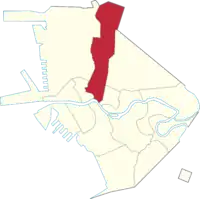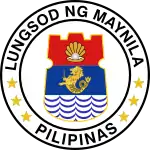Santa Cruz, Manila
Santa Cruz is a district in the northern part of the City of Manila, Philippines, located on the right bank of the Pasig River near its mouth, bordered by the districts of Tondo, Binondo, Quiapo, and Sampaloc, and Grace Park (Caloocan City) and La Loma (Quezon City). The district belongs to the 3rd congressional district of Manila in the Philippines.
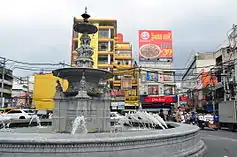 | |
|
| |
| City | Manila |
|---|---|
| Population (2007)[1] | 118,779 |
| – Density | per km² |
| Area | km² |
| – Barangays | 82 |
| – Cong. Districts | 3rd District |
History
Spanish colonial era
Prior to the arrival of the Spanish conquistadors to the Philippine Islands, the district of Santa Cruz was partly a marshland, patches of greeneries, orchards and partly rice fields. A Spanish expedition in 1581 claimed the territory and awarded to the Society of Jesus whose members are known as 'Jesuits'.
The Jesuits built the first Roman Catholic church in the area where the present Santa Cruz Parish stands on June 20, 1619. The Jesuits enshrined the image of the Our Lady of The Pillar in 1643 to serve the pre-dominantly Chinese residents in the area. The image drew a lot of devotees and a popular cult grew around it.
On June 24, 1784, King Carlos III of Spain gave the deeds to about 2 km² of land that was part of the Hacienda de Mayhaligue to the San Lazaro Hospital which served as a caring home for lepers in Manila at that time.
At the Santa Cruz Parish, a small park was built that linked the area into the headquarters of the Spanish cavalry, the building that once was the Colegio de San Ildefonso, operated by the Jesuits. The district in the Spanish times also had a slaughter house and a meat market and up north was the Chinese cemetery.
The Franciscan fathers were given the responsibility to care for the lepers of the city and specifically the San Lazaro Hospital. Father Felix Huerta developed San Lazaro into a refuge for the afflicted and it became a famous home for those afflicted in the north side of the Pasig River.
World War II
During World War II, the Japanese occupational forces, caught unaware of the fast approaching liberation by the combined American & Filipino soldiers from the north, abandoned in 1945 the northern banks of the Pasig River including Santa Cruz. Santa Cruz and much of the northern portions of Manila were spared from the artillery bombardment and to date, a number of pre-World War II buildings and houses still stand in Santa Cruz.
When the Philippine republic was finally established in July 1946, the San Lazaro Hospital complex became the head office of the country’s Department of Health.
Notable buildings
Santa Cruz Parish Church
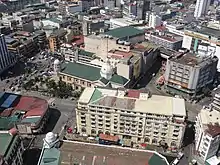
The first Santa Cruz Church was built when the Arrabal (Suburb) of Santa Cruz was established by the Jesuits in the early 1600s. The church had undergone many repairs and reconstruction, with the last reconstruction done in the 1950s. Today, the church architecture employs a California Spanish Mission style facade silhouette with the usual Filipino (Asian-Hispanic mix) Baroque ornamentation. The church facade is topped with an effigy statue of Our Lady of the Pillar, the patroness of the church whose feast happens every third Sunday of October and on the 12th day of October.
Cemeteries
Santa Cruz is home to Manila's oldest cemeteries located in the district's northern section namely, La Loma Cemetery, the Manila Chinese Cemetery, and the city's biggest, the Manila North Cemetery.
Main thoroughfares
Rizal Avenue is the main thoroughfare in the district. The district is also accessible via the following roads:
Stations of the Manila Line 1, commencing from Baclaran and Roosevelt stations, are in Carriedo, Doroteo Jose, Bambang, Tayuman and Blumentritt. The Philippine National Railways has a station in Blumentritt. Jeepneys coming from Baclaran and Caloocan pass through Rizal Avenue.
Gallery
Religious buildings
 Santa Cruz Church
Santa Cruz Church Espiritu Santo Parish Church
Espiritu Santo Parish Church San Roque Church
San Roque Church Bethel Knox United Methodist Church
Bethel Knox United Methodist Church
Civic institutions
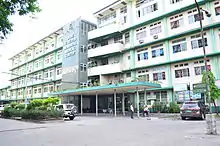 Jose Reyes Memorial Medical Center
Jose Reyes Memorial Medical Center Chinese General Hospital
Chinese General Hospital
 Chinese Cemetery
Chinese Cemetery
Commercial establishments
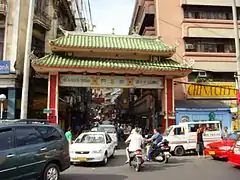 Chinatown (Plaza Santa Cruz), Third Welcome Gate (Arch of Goodwill) to Ongpin Street towards Binondo
Chinatown (Plaza Santa Cruz), Third Welcome Gate (Arch of Goodwill) to Ongpin Street towards Binondo Ongpin Commercial Center
Ongpin Commercial Center Bank of the Philippine Islands at Don Román Santos Building, a neo-classical, Graeco-Roman structure at Plaza Goiti (now Plaza Lacson)
Bank of the Philippine Islands at Don Román Santos Building, a neo-classical, Graeco-Roman structure at Plaza Goiti (now Plaza Lacson) Carriedo Street with Plaza Lacson in the background
Carriedo Street with Plaza Lacson in the background Commercial Buildings in Rizal Avenue
Commercial Buildings in Rizal Avenue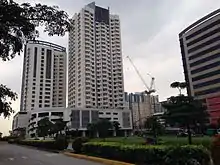 San Lazaro Tourism and Business Park (formerly the San Lázaro Racetrack)
San Lazaro Tourism and Business Park (formerly the San Lázaro Racetrack) Capitan Pepe Building
Capitan Pepe Building
Residences
 Bahay na bato house in Santa Cruz, Manila
Bahay na bato house in Santa Cruz, Manila Bahay na bato apartments in Santa Cruz, Manila
Bahay na bato apartments in Santa Cruz, Manila Period architecture in Santa Cruz, Manila
Period architecture in Santa Cruz, Manila Bahay na Bato House in Bambang Rizal Avenue
Bahay na Bato House in Bambang Rizal Avenue
See also
References
- Final Results - 2007 Census of Population Archived 2012-07-16 at the Wayback Machine
External links
 Media related to Santa Cruz, Manila at Wikimedia Commons
Media related to Santa Cruz, Manila at Wikimedia Commons Santa Cruz, Manila travel guide from Wikivoyage
Santa Cruz, Manila travel guide from Wikivoyage
